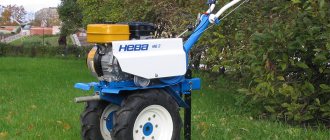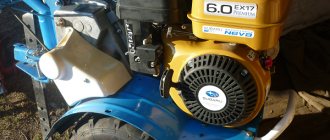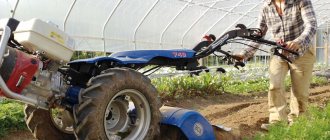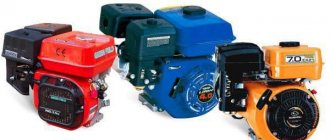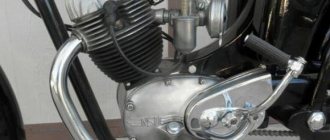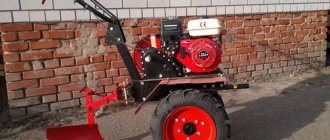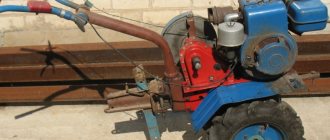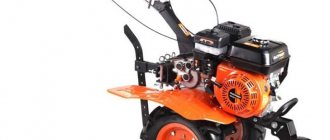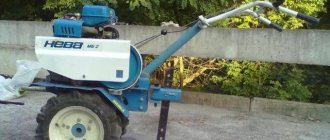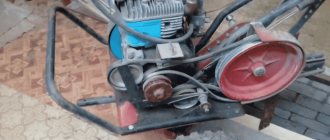The range of tillage equipment is striking in its diversity. Modern walk-behind tractors have long gone beyond the limits of what is possible and, in addition to tillage, are capable of performing a number of other technological operations - cutting feed, transporting large cargo, sowing and harvesting crops, functionally replacing a dozen expensive devices on the farm. All of them are available with gasoline and diesel power plants. Therefore, the first question with which their purchase begins concerns which engine - diesel or gasoline - is best to give your preference. We will talk about how not to make a mistake with your choice and invest money wisely in this article.
The best foreign models
Prorab GT 80 RDK
It differs in engine power - 8 horsepower.
It is characterized by a cutter diameter of 3 meters. Cultivation depth – 250 mm. It processes soil to a width of 75 cm at a time. Equipped with a diesel engine.
Champion DC1193e
This heavy-duty walk-behind tractor is considered one of the most popular. Fuel tank – 5.5 l. Engine capacity – 418 cc. Unit weight – 177 kg. It features two forward gears and one reverse gear.
Plows the ground to a depth of 30 cm and a width of 110 cm.
It is characterized by a fairly powerful engine - 9.5 horsepower.
Huter GMC-9.0
The engine is powerful here too – 9 horsepower. Features manual start. The diameter of each cutter is 32 cm.
The unit is equipped with pneumatic wheels, ensuring high maneuverability of the equipment. The weight of the walk-behind tractor is only 135 kg.
Huter GMC-9.0 walk-behind tractor
Garden Scout GS81
The heavy Scout walk-behind tractor has gained popularity among agronomists due to the following characteristics:
- powerful trailer with a load capacity of up to 1000 kg;
- engine power is almost 10 horsepower;
- Suitable for cultivating a plot of land of 2-3 hectares.
Aurora COUNTRY 1400
It features high engine power - as much as 13 hp. It has an “easy start” system that allows you to start the engine in any weather.
The gasoline engine works best on the AI-92 brand.
Prorab 904VD
Can process 800-1100 mm of soil at a time. Engine capacity – 418 cc. cm, and power – 9 horsepower. Runs on diesel. Equipped with a gear reducer.
Caiman 340
One of the most expensive units. It cultivates soil to a width of 90 cm and a depth of 22 cm. It weighs a little - 107 kg, but sits deep. The relatively low weight helps to increase the maneuverability of the unit.
Champion GC2423
Quite a cheap model made in China. Engine power – 1.87 hp. Plows ruts to a width of 23 cm and a depth of 22 cm.
Which is better walk-behind tractor Oka or Neva
In order to find out what is better to buy: the Oka or Neva walk-behind tractor, let’s analyze the reviews of the owners, technical characteristics and current prices on the garden equipment market.
To compare two brands of walk-behind tractors and understand which one to choose, let’s look at their pros and cons.
- Motoblocks from "CADVI" Oka
- The advantages are the modular design, which allows you to equip the walk-behind tractor with any attachments; equipped with durable Japanese motors providing high performance.
- Disadvantages: small processing area (up to 60 acres), high cost and difficulty in troubleshooting independently, in comparison with similar Neva walk-behind tractors.
Motoblocks from Neva
- Pros: equipped with high-quality Briggs & Stratton, Yamaha, Honda and Kasei engines; the design is carefully designed and time-tested, optimized for all agricultural work; the MultiAgro gear mechanism allows you to increase the number of gears; ease of maintenance and repair.
- Cons: limited compatibility with attachments from other manufacturers; it costs expensive.
What can be concluded? If you need a unit for infrequent work on plowing, mowing, harvesting and planting potatoes in a small dacha or vegetable garden, then a cheaper option - the Oka walk-behind tractor - is quite suitable. But if the machine is fully loaded, and various agricultural work is planned to be carried out on a large area, purchase a more reliable Neva, which you will definitely recommend to your neighbors after many years of use.
Firework
Salute takes second place. On the first - Neva. There are 2 models of this type of walk-behind tractor: Salyut-5 and Salyut-100. They have been produced at the Moscow enterprise "Salut" for more than 20 years. The domestic product is equipped with foreign-made engines. Salyut-100 has been produced since 2013. It is assembled in China.
Salyut-5. The Salyut walk-behind tractor was developed by domestic aviation engineers. It is equipped with a gear reducer, which is not afraid of loads. Two forward and one reverse gears allow you to cultivate small and medium-sized plots of land. You can attach a feed chopper or a woodworking machine to the unit.
The center of gravity is low, which makes the machine stable on slopes. The adjustable steering column is convenient for those working with equipment. It is used for agricultural work in the garden, for cutting grass, cleaning streets, and transporting goods.
Salyut-100. This model is superior to the previous one. Gear shifting is carried out from the steering wheel, which is adjustable in different directions. The reliable gear reducer requires no maintenance and works with any engine. The set includes a set of keys and high quality forged cutters.
Gasoline walk-behind tractor: important nuances of equipment
Gasoline walk-behind tractors - 2-stroke or 4-stroke carburetor units. Their main difference is that the combustion process of gasoline begins with a spark from spark plugs, and not from glow plugs, like a diesel engine.
"Pros" of gasoline walk-behind tractors:
- lightness and small size - ensure ease of control, which will be within the power of a person with average capabilities;
- reliability regardless of the season - gasoline walk-behind tractors turn on reliably both in hot and cold weather, even without electric ignition;
- sound pressure reduced by a third compared to diesel tillers;
- almost imperceptible mechanical vibrations of the steering column to preserve health;
- a wide range of models - gasoline walk-behind tractors are produced by both domestic and foreign manufacturers. Therefore, the user has a greater chance of finding the best price-quality ratio for himself;
- lower cost of spare parts, which allows repairs to be made with minimal losses to the family budget.
The “disadvantages” of gasoline walk-behind tractors are:
- high fuel consumption - they need to refuel with fuel with an octane rating of at least 92 (and some even 95), the price of which is steadily increasing. And if you consider that the average gasoline consumption is about 2 l/h, ensuring its viability becomes by no means a cheap pleasure;
- small power reserve;
- unsuitability for prolonged loads without breaks - due to the inadequacy of the cooling system, gasoline walk-behind tractors need to be given regular breaks.
Attachments for walk-behind tractors Foreman
The Foreman family of walk-behind tractors stands out among identical machines of other brands due to its expanded basic configuration: tillers, plow, spare wheel, operator's seat, walk-behind tractor operating manual and warranty card with certificates.
Depending on the type of crops grown and the needs of a particular farm, it is optionally possible to purchase a wide range of additional original attachments:
- Hillers - thanks to their manufacture from high-strength steel, they can be used for hilling plants and inter-row cultivation.
- Harrow – used for processing various soils.
- "Crow's feet" - loosen the soil, simultaneously crushing and mixing weeds.
- Plows - double and triple, plow the ground, working width is 40 cm and 60 cm, respectively, with a working depth of 18-25 cm.
- Potato digger – designed for digging up potatoes.
- A seeder is a device for sowing various crops.
- Rotary mower – mows grass.
- Metal lugs - used in some modifications of Prorab walk-behind tractors, they serve for better traction with the ground.
- Motor pump – provides pumping of water for irrigation of crops.
- Blade shovel – used for snow removal.
- Adapter with seat – makes work easier for the operator.
- Trailers, carts - designed for transporting various goods.
How to choose a walk-behind tractor?
Before purchasing a unit, you need to focus on the set of operations that the walk-behind tractor will have to perform. You should not buy the most expensive modifications of units that have a full range of functions in their arsenal. Not every model can cope with the task.
For example, in large areas with dense soil, the best option would be to purchase a heavy unit, while in a small dacha, a light-class walk-behind tractor will be sufficient.
When choosing, you also need to decide on the type of fuel on which the agricultural machine will operate. Units with a gasoline engine are quieter, lightweight, and easy to maintain. Diesel walk-behind tractors are noisier, but they take the cake with their high power. The disadvantage of diesel is its high price.
Please note that additional attachments may often be provided by another manufacturer. In this case, an adapter will be required to connect the implement to the purchased walk-behind tractor. This may result in unit malfunction or problems in performing the job.
The range of walk-behind tractors on the market today is quite diverse. Models from companies such as Husqvarna, Profi, Hyundai are in great demand. In our country and neighboring countries, such cars as “Belarus”, “Neva”, “Salyut-100” are presented. Of course, one should not discount the Chinese companies Forte and Wiema, because their products are also quite in demand.
If you compare foreign models with domestic analogues, you can see that their cost is not always justified by reliability and ease of use. In addition, imported models will require expensive consumables and the presence of experienced specialists for maintenance. Both can be very difficult to find.
Domestic companies are focused on ease of use and low cost. The decisive factor is the ability to repair the walk-behind tractor on your own.
So what to choose: a gasoline or diesel unit?
The answer to this question can be provided by the person himself, having decided and analyzed the data regarding the potential scope of work of the unit. The final choice depends on the required power, the area of use, the gravity of the land, the frequency of operation and the financial capabilities of the person. When giving preference to gasoline or diesel, you should also think about the advantages that it will receive from using each type. Thanks to this simple method, you can quickly get an answer to a seemingly complex question.
The best medium-sized Russian walk-behind tractors
Tselina NMB-901
Powerful walk-behind tractor with a gasoline engine of the Lifan 177F series. It improves traction, reduces fuel consumption, is durable and reliable.
A distinctive feature is an automatic transmission with 3 main speed modes.
The equipment allows you to process areas of up to 1,200 square meters. m in a short period of time.
Characteristics:
- cultivation width - 72-113 cm, depth - 30 cm;
- engine type - 4-stroke with 1 cylinder, volume - 270 cc. cm, power - 9 l. With.;
- traction force - 15.5 kN, fuel consumption - 374 g per hour of operation;
- there is a power take-off shaft, disc clutch, gear reducer, reverse;
- noise level - 92 dB;
- fuel tank volume - 3.6 l;
- dimensions - 136x70x100 cm;
- weight - 123 kg.
Advantages:
- smooth running when switching speed mode;
- Russian quality, time-tested;
- suitable for equipping with attachments;
- strength of parts, durability.
Flaws:
not equipped with cutters.
Neva MB-2KS-(168FA)
Petrol model with manual transmission, gear-chain drive and 6 speed modes. Pneumatic wheels allow you to withstand the weight of a walk-behind tractor paired with attachments.
Smooth running and excellent maneuverability make the unit the best in its line.
Characteristics:
- plowing depth - 20 cm, width - 81-126 cm;
- there is a power take-off shaft, reverse;
- engine volume - 196 cubic meters. cm, power - 6.50 l. With.;
- fuel tank volume - 3.6 l;
- weight - 85 kg.
Advantages:
- high-quality cultivation of any soil for subsequent planting of various crops;
- convenient control due to a well-designed frame;
- controls are located on the handle;
- there is good traction between the wheels and the ground surface;
- saving fuel consumption, the ability to use any type of gasoline.
Flaws:
No.
Neva MB-23B-10.0
Decent model with original Briggs and Stratton petrol engine. The engine has high performance - 10.06 liters. With.
The walk-behind tractor perfectly demonstrates its capabilities in all weather conditions.
Wheel towing is eliminated, so the unit moves smoothly and quickly.
Characteristics:
- availability of 6 cutters with max. rotation - 160 rpm. minute;
- plowing depth - 20 cm, width - 86-127 cm;
- There is a manual transmission, reverse, gear reducer;
- weight - 105 kg.
Advantages:
- good maneuverability;
- high strength of structural elements;
- the unit has a long service life, designed for 10 years or more;
- cutters do not require additional processing or regular maintenance;
- fuel economy;
- affordable price.
Flaws:
No.
Neva MB-23-Y (MX300) with MultiAgro gearbox
Powerful walk-behind tractor with gear-chain drive, belt clutch, reverse and 6 speed modes. The uniqueness lies in the fact that the unit is equipped with a MultiAgro gearbox.
Thanks to it, the user can choose the appropriate speed, enjoy excellent maneuverability, appreciate the high-strength housing and streamlined shape of the gearbox.
Characteristics:
- cultivation width - 85 cm, depth - 25 cm;
- presence of 4 cutters with a diameter of 36 cm;
- there is a power take-off shaft, the ability to unlock the differential;
- engine type - four-stroke with 1 cylinder, volume 305 cc. cm;
- fuel tank volume - 3 l;
- weight - 86 kg.
Advantages:
- MX300 engine from Yamaha;
- easy start of the starting system;
- the gearbox pleases with its uninterrupted operation;
- durability of the overall design, high performance;
- The price matches the build quality.
Flaws:
not detected.
AGATE L-6.5
The gasoline walk-behind tractor is equipped with a Lifan 168A-2 series engine. The design element has proven itself well, thanks to economical fuel consumption and sufficient volume.
Thanks to a well-thought-out assembly, a walk-behind tractor can plow up to 5,000 square meters. m of land.
It has 3 main speed modes, a gear drive with a belt clutch and reverse.
Characteristics:
- cultivation width - 60 cm, depth - 30 cm;
- complete with 4 cutters;
- engine type - four-stroke with 1 cylinder, volume 196 cc. cm, power 6.50 l. With.;
- fuel consumption - 395 g per one hour of operation;
- fuel tank volume - 3.6 l;
- dimensions - 82x53x86 cm;
- weight - 84.7 kg.
Advantages:
- easy-to-use handle;
- the presence of a bracket for installing attachments;
- pneumatic wheels perfectly withstand the final weight of the unit;
- excellent maneuverability;
- durability and reliability.
Flaws:
No.
Which walk-behind tractor is better, diesel or gasoline?
So, diesel or gasoline?
The design and operating features of certain units vary significantly. There are also differences in service life, fuel consumption, maintenance costs and comfortable working conditions. Why is a diesel walk-behind tractor better than a gasoline one?
- Economical fuel consumption. Even if the engine is very powerful, diesel consumes much less than gasoline;
- No ignition system. Therefore, the engine will not need frequent repairs, replacement of spare parts and adjustments of the unit;
- The walk-behind tractor will last for many years.
Why is a gasoline-powered walk-behind tractor better than a diesel one?
- Quiet operation;
- Ability to process complex areas and small areas;
- Easy controls. With low steering vibration, even a novice operator can control the walk-behind tractor.
A walk-behind tractor is often selected based on the personal wishes and requirements of the owner. It is worth noting that gasoline units can process areas within 30 acres, and diesel units can process large, heavy areas.
Chain or gear
A chain drive is a mechanism for transmitting motion using toothed sprockets and chains. The mechanism has its own advantages:
- transmits movement over long distances;
- one chain can rotate several shafts;
- high transmission stability and efficiency.
The disadvantages include:
- increased noise level;
- intensive chain wear;
- gradual stretching of the chain;
- high price.
Chains come in roller, bushing and toothed types.
The gear reducer is more complex than all the others. During operation, it reduces engine speed and increases the power output of the unit. A good walk-behind tractor is equipped with such an air-cooled gearbox. It may have a reverse, allowing the walk-behind tractor to move backwards. Disassembling and replacing gears is not difficult. In Chinese-made installations, non-separable gearboxes are used. If they break, you need to replace the entire body along with the filling.
Diesel walk-behind tractor: pros and cons of the design
Until recently, a walk-behind tractor or any other gardening tool powered by a diesel engine was considered fantastic. In the last decade, with the advent of small-sized diesel engines, this prospect has become a reality.
Advantages of diesel walk-behind tractors:
- low specific energy consumption - compared to gasoline engines of similar power, this indicator has a difference of 20%;
- increased torque - it manifests itself even at low speeds and makes the unit more resilient to increased loads;
- long service life - on average, all diesel walk-behind tractors are designed for 3 thousand hours of operation, which is almost 2 times higher than the same value for gasoline ones;
- significant structural weight is an important advantage for cultivating any type of soil. Due to their improved adhesion to the underlying surface, they can easily loosen even virgin soil and heavy soils with a plow and do not require the installation of weighting agents. On light sandy and sandy loam substrates, diesel walk-behind tractors move without slipping on conventional pneumatic wheels, which avoids additional costs for lugs;
- greater environmental friendliness - the composition of exhaust gases after the combustion of diesel fuel is safer than those from gasoline engines.
Flaws:
- the high cost of all diesel equipment, which results in the high cost of its repairs and scheduled maintenance;
- difficulties with starting diesel power plants in the winter - to eliminate this problem, users will have to fork out for antifreeze additives to the fuel or, if there is no electric starter, install it additionally;
- increased vibration-noise effect;
- poor maneuverability and, as a result, high power consumption for the operator.
Specifics of diesel walk-behind tractors
It is worth immediately noting that these objects are intended for processing large areas. High traction force allows them to function successfully at low speeds. This makes them ideal for hilling, plowing, cultivation and more.
Advantages of diesel walk-behind tractors:
- Low fuel consumption. Diesel consumption depends on engine power, but even a device with 12 hp. With. will be quite economical;
- Ease of maintenance and repair. The unit does not have spark plugs, a carburetor and a magneto, which often cause the device to break down;
- Heavy weight. This factor guarantees excellent grip on the ground and does not require the purchase of special weights;
- Variety of cooling types. To reduce the temperature, both water and air are used (gasoline walk-behind tractors do not have water cooling).
A diesel engine has an incredible supply of resources, so it can perform the task assigned to it for a long time and with high quality.
Disadvantages of diesel walk-behind tractors:
- High price. But it pays off quite quickly, because the price of fuel is relatively low;
- The need to periodically force the device to work at maximum power. Many do not consider this feature as a negative, but still the fact that idling can lead to malfunctions is quite annoying.
You should get acquainted with several diesel models that are considered the most popular in the domestic space:
- Neva MB-23SD;
- Patriot Garden T7.0;
- Scout 15 DE;
- Crosser CR-M10;
- Champion DC1193E.
Often, the frame in such units is coated with special corrosive substances, and the gearbox is made of cast iron alloy, which protects against negative influences due to sudden changes in load.
What is the difference between diesel walk-behind tractors?
- Firstly, they have incredible motor potential. Moreover, the devices can withstand even heavy loads, but before starting operation it is necessary to break in the walk-behind tractor, following the generally accepted rules of this process. Under no circumstances should it be used at maximum power; this is allowed only after all parts have been ground in;
- Secondly, they have high efficiency;
- Thirdly, the devices consume little fuel and have large fuel tanks;
- Fourth, the fixtures are known for their durability and long service life;
- Fifthly, the money spent on the purchase pays off quite quickly;
- Sixthly, diesel walk-behind tractors with a PTO are ideal for performing painstaking work of any complexity.
Choosing the right diesel walk-behind tractor
In order not to make a mistake with the purchase, you need to pay attention to the following points:
- Device power. It is advisable to calculate the approximate power of the desired device based on the area of land being cultivated;
- Availability of differentials. It will improve the maneuverability of the walk-behind tractor and speed up the process of excavation work.
- Weight. By choosing an option with a large weight, a person can be sure that the walk-behind tractor will be able to cultivate a large area of land with minimal fuel costs and will cope even with heavy soil. Lighter units are suitable for working in small areas;
- Availability of electric starter. It allows you to quickly start the walk-behind tractor and create better operating conditions;
- Possibility of installing a variety of attachments. Will improve performance.
- Availability of options such as plowing, weeding, hilling. In this case, the choice depends on the main tasks for which the mechanism is purchased.
This is interesting: Champion walk-behind tractors: models, capabilities, video
Features, advantages and disadvantages of gasoline walk-behind tractors
Distinctive features of gasoline models are light weight and maneuverability. Such a walk-behind tractor starts thanks to a spark arising from the spark plug. It is also capable of operating at idle for a long time. To prevent the engine from overheating, air cooling is used.
The gasoline engine will start at any outside temperature and in any weather. This greatly simplifies the process of using such technology.
Among the advantages it is worth noting:
- More affordable price. Such models are cheaper than diesel ones.
- Noise during operation is significantly less.
- It was noted that gasoline equipment can start working at any outside temperature.
- It is quite easy to operate the walk-behind tractor thanks to the weak steering vibration.
- It is not necessary to use an electric starter to start the equipment.
- Gasoline, which is available, is used as fuel.
- Easy maintenance. Most problems can be fixed with your own hands. Contacting specialists is required in rare cases.
@yandexmarket
But gasoline types have some disadvantages. Among the main ones:
- Can only be used at high speeds. The equipment will not function at minimum.
- Such a walk-behind tractor is capable of processing only small areas or medium ones - no more than 40 acres.
- Due to the air type of cooling, such a walk-behind tractor is not suitable for long-term use. It is necessary to take regular breaks, which increases working time.
"Belarus 09N-01"
The most popular model among domestic consumers among other competitors of the heavy group is the Minsk “Belarus 09N-01”. This walk-behind tractor cannot be called a new product, because the ninth series has been produced since back in 1991. Many years of experience and feedback from the owners have made it possible to eliminate all the shortcomings of previous generations, so there are no serious problems with the operation of the device.
Previous lines were equipped with Chinese units - noisy and not the most economical, but this modification received a good engine from Honda that runs on gasoline. In addition, the new version has a low-range transmission, that is, two gears back and four gears forward. The model also does not have any traction problems - the equipment easily develops a force of up to 100 kgf. The gearbox with a smart differential can be forcibly locked, and in the rear part of the gearbox there is a power take-off shaft for more flexible operation of the walk-behind tractor.
Key Differences
It’s easy to guess that the main difference between a gasoline walk-behind tractor and a diesel one is the type of engine installed, which can be gasoline or diesel, respectively. But are there other differences in the design of the units? Practically no, that is, in theory, any model can be equipped with any type of engine.
In addition to the fuel used, the main differences lie directly in the ignition system. Thus, the gasoline mixture is ignited by a spark produced by a conventional spark plug, and the diesel mixture is ignited by self-ignition from the compression ratio in the cylinder.
Ugra NMB-1N13 – the best domestic walk-behind tractor
The best domestically produced walk-behind tractor of the middle category, weighing 90 kg. Designed for processing large plots of land. On board: 4-stroke engine with 6 hp. With. with a volume of 170 cubic meters. see, gear reducer with power take-off shaft. The ratio of width and depth of cultivation is 90/32 cm. Such a “comrade” is capable of performing any work. Fuel tank capacity 3.1 liters. Box with 3 forward gears and 1 reverse gear.
The walk-behind tractor is mechanically activated; the steering column can be adjusted in two positions: vertical and horizontal, which ensures low vibration. Having slightly disassembled the walk-behind tractor, you can easily transport it to your destination. Costs about 43 thousand rubles.
"Neva MB-1B-6.0FS" is one of the most powerful walk-behind tractors in the group of light models. It is popular among compatriots due to its simplicity of design, the latest Briggs & Stratton engines, the ability to purchase spare parts at any agricultural store and the price of 46 thousand rubles.
Medium-power copy - 6 horsepower with a volume of 208 cubic meters. see that for light models this is the best indicator. Despite the Chinese assembly, there are no complaints about the quality of the product.
This assistant is used both on light and heavy soils to transport cargo without loss of maneuverability in work. A bonus to the basic package is the presence of headlights. General characteristics: versatility, 3-speed transmission, weight - 75 kg and chain-type gearbox.
The Belarusian “Belarus 09N-01” has been produced since 1991, therefore, in view of the accumulated experience, the manufacturers have eliminated all the shortcomings of the first generation. The updated unit is equipped with a Honda gasoline engine, a low-range transmission, a gearbox with a differential and a power take-off shaft. The only negative is considerable fuel consumption. Costs 80 thousand rubles.
The high-speed, powerful model “Centaur MB 1080D-5” (8 horsepower) performs high-quality processing, despite its speed. The maximum possible speed is 21 km/h, provided when milling the soil, and a lower gear is used for working with a plow. The weight of the unit is 252 kg and the tank volume is 5.5 liters. The cost of such a powerful walk-behind tractor is about 68 thousand rubles.
"Caiman 340" and "Champion GC2423"
The expensive “Caiman 340” fully corresponds to the price-quality category. The Subaru 4-stroke engine produces 14 hp. With. with a volume of 404 cubic meters. cm. The width and depth of the track are 90 and 22 cm, respectively. Despite the weight of 107 kg, the equipment does not lose maneuverability. Price - about 180 thousand rubles.
Significantly cheaper is the less powerful Chinese-made “Champion GC243” with a 1.7 liter engine. With. and one transfer. The track width is 23 cm, the depth is 22 cm. The price – 9.5 thousand rubles – is not high, but the walk-behind tractor copes with the main function.
"Zirka GN-151E"
The best and most powerful Chinese copy of the Zirka GN-151E is considered professional equipment, but in fact it is a miniature tractor, weighing half a ton. Unit components:
- 4-stroke diesel engine, 15 hp. With. and a volume of 903 cubic meters. cm.;
- 8 gears in the box (6 forward, 2 reverse), which allows you to easily work on heavy soil;
- electric starter;
- 7-liter fuel tank;
- halogen headlight allows you to work at night;
- mount for attachments;
- 3 wheels;
- sitting
The produced track width is 1 m, with a depth of 25 cm. The cost of the model is about 172 thousand rubles.
"Viking VH400"
The simplest and less powerful machine is considered to be the “Viking VH400” for 20 thousand rubles. This is a light category unit, weighing only 38 kg. The engine power from Briggs & Stratton is also low - 3.5 liters. s., and the fuel tank – up to 2 liters.
